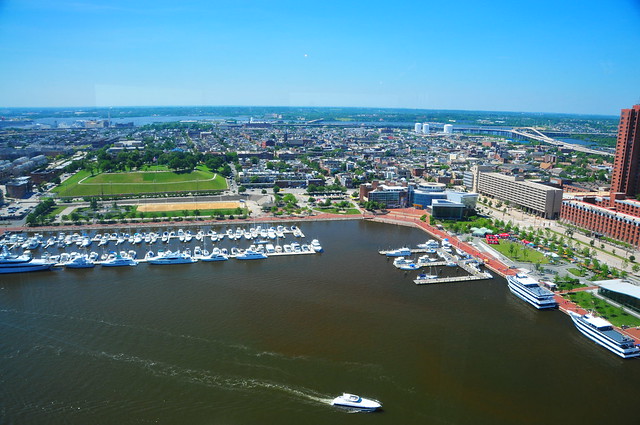
These two neighborhoods have quickly become the destinations of choice for affluent young professionals desiring an urban lifestyle close to downtown. They're within walking distance of businesses and just across the harbor from popular locations such as the aquarium. Two professional league sports stadiums are a few minutes drive away across the highway. Perhaps one of the greatest advantages over, say, Bolton Hill, is the large presence of restaurants, cafes, and shops on Cross, Charles, and Light Streets. Cross Street Market, first established in 1846, has dozens of stalls selling fresh produce and seafood. It's easily manageable to fill most weekly needs without leaving the area. And of course there is the area's namesake, Federal Hill Park, with views over the entirety of downtown and the harbor.
Federal Hill wasn't always the affluent neighborhood it is today. Bordering the harbor, historically it's been home to merchants, dock workers, and the military. Consequently you don't find the sort of elegant blocks of rowhomes that Bolton Hill has. Rather, the homes here are of mixed sizes, styles, and eras, with a few not even built of brick but timber. Timber homes were not outlawed until the early 1800's. When the docks lost their importance after WWII, the neighborhood fell into decay and was nearly bulldozed to make way for new highways. Luckily, a strong backlash forced the highway westward and the historic homes were slowly rehabilitated and renovated, thanks largely to the government which encouraged the initiative by selling homes for under $10,000. Today some of the largest homes sell for over $1 million although a fixer-upper can be found for around $200,000.
Otterbein is technically a separate neighborhood but nowadays the two are quite dependent. It's the same shopping and social circle. The neighborhood is after all just a few blocks, having suffered more development in the past several decades. Many homes were destroyed before commencement of a homesteading program, which offered homes for $1 in exchange for an active role in rehabilitating the neighborhood. The remaining empty plots were turned into small parks and modern townhomes and condos. Today Otterbein has the highest average property prices in Baltimore city.











 |
| This home on the corner of William and Warren, one block from the park, is on the market for $1.2 million |

























 |
| Otterbein |













In preparing this post I read about the emergence of families in the neighborhood, which was definitely heartening as many of these kind of neighborhoods are able to attract young professionals but they disappear as soon as they marry and have kids. This makes for a mono-dimensional place to live with a limited selection of amenities and the same kind of people out and about. Worst, it makes a neighborhood dependent on the fixations of one particular group and very resistant to ups and downs within that group. If employment among graduates drops, for example, the neighborhood suffers. A neighborhood which welcomes families is more alive, friendlier, and much more successful economically and guarantees a stable tax base for the city. And it certainly prevents a perpetual college-town atmosphere. One thing families would appreciate are stores beyond what boutiques can offer. Something like a Target or a department store. Larger stores are a rarity even downtown.
The city of Baltimore is definitely missing the mark when it comes to ensuring a great standard of life. Access to the waterfront from Federal Hill is cut off by the Key Highway and from Otterbein one must overcome the eight lanes of Light Street. I know the city is struggling financially but there could really be a fantastic interchange between the neighborhoods and the waterfront if the roads were pushed under as Seattle and Boston have recently done. Baltimore's population keeps dropping and is unlikely to recover unless the city pulls all the stops to convince residents of the superiority of urban living. One of the things HBO's The Wire teaches is that this isn't going to be easy. It's unfortunate that doing the right thing has been lost from the vocabulary of daily politics.
 |
| Federal Hill from a downtown skyscraper. flickr : mbell1975 |
